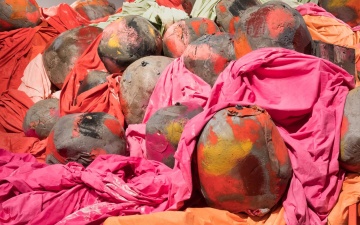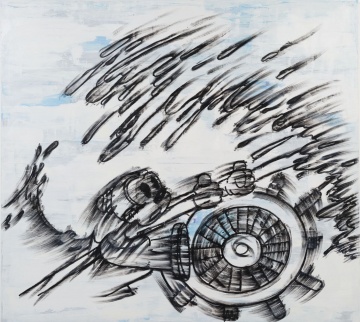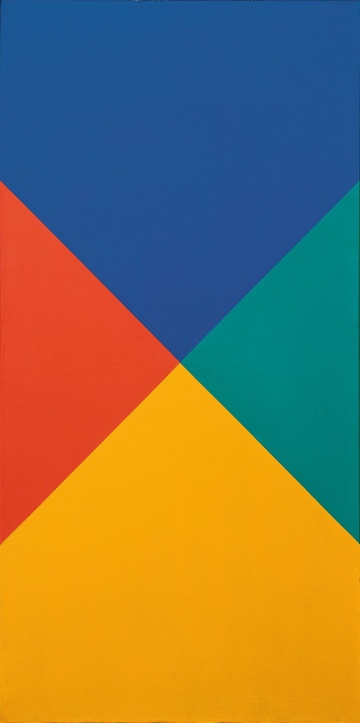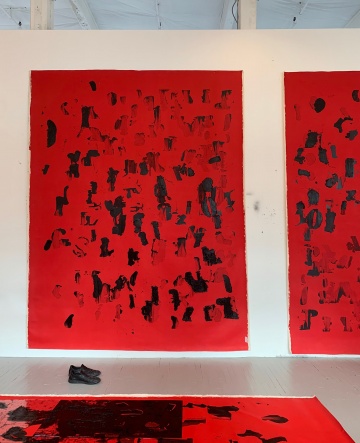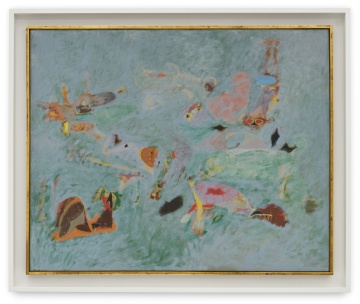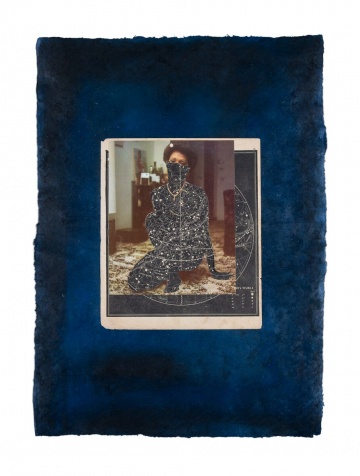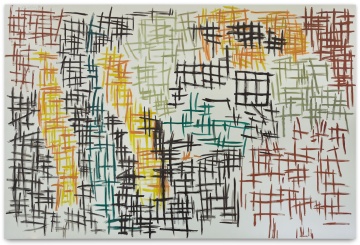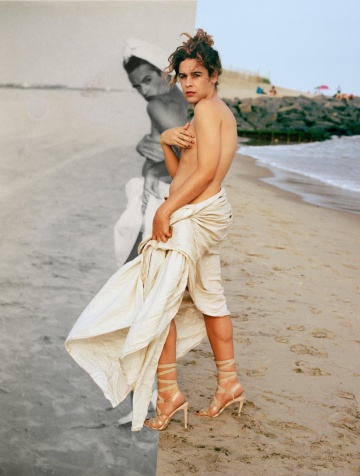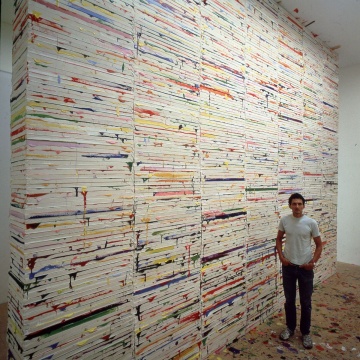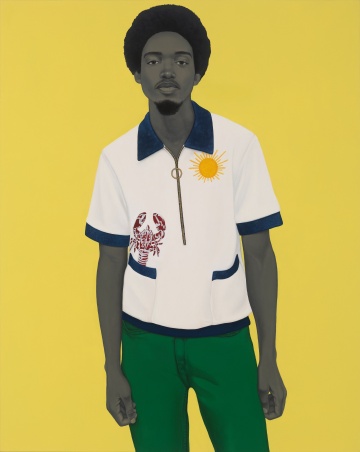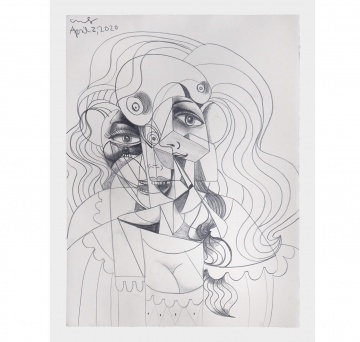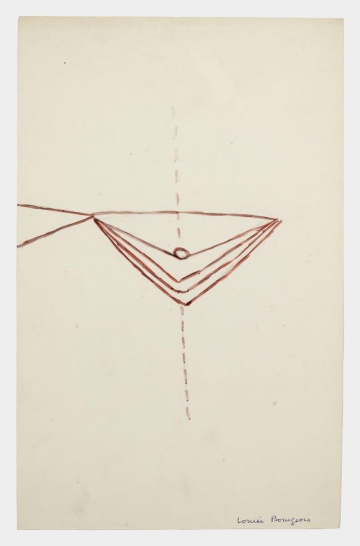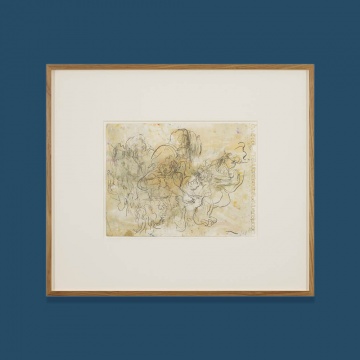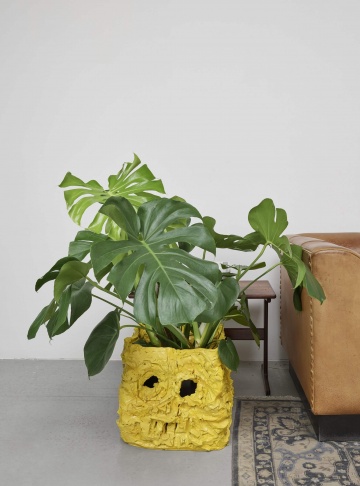Hauser & Wirth
32 East 69th Street
New York, NY 10021
212 794 4970
Also at:
542 West 22nd Street
New York, NY 10011
212 790 3900
901 East 3rd Street
Los Angeles, CA 90013
213 943 1620
9 Main St
Southampton, NY 11968
Appointment Recommended
631 609 6331
Tweets by HauserWirth
New York, NY 10021
212 794 4970
Also at:
542 West 22nd Street
New York, NY 10011
212 790 3900
901 East 3rd Street
Los Angeles, CA 90013
213 943 1620
9 Main St
Southampton, NY 11968
Appointment Recommended
631 609 6331
Artists Represented:
Rita Ackermann
Ida Applebroog
Hans Arp
Phyllida Barlow
Larry Bell
Max Bill
Louise Bourgeois
Frank Bowling
Mark Bradford
Geta Brătescu
Stefan Brüggemann
Alexander Calder
John Chamberlain Estate
The Estate of Eduardo Chillida
Ed Clark
George Condo
Martin Creed
Roberto Cuoghi
Berlinde De Bruyckere
Nicole Eisenman
The Estate of Günther Förg
Charles Gaines
Ellen Gallagher
Isa Genzken
The Estate of Leon Golub
Arshile Gorky Estate
Rodney Graham
Subodh Gupta
The Estate of Philip Guston
Mary Heilmann
The Estate of Eva Hesse
Jenny Holzer
Roni Horn
Luchita Hurtado
Pierre Huyghe
Matthew Day Jackson
Richard Jackson
Rashid Johnson
Allan Kaprow Estate
Mike Kelley Foundation for the Arts
Rachel Khedoori
Bharti Kher
The Estate of Tetsumi Kudo
Guillermo Kuitca
Maria Lassnig
Annie Leibovitz
Zoe Leonard
Glenn Ligon
The Estate of Lee Lozano
Anna Maria Maiolino
Fondazione Piero Manzoni
Takesada Matsutani
Estate of Fabio Mauri
Paul McCarthy
Don McCullin
Estate of Fausto Melotti
Gustav Metzger
Henry Moore Family Collection
François Morellet
Angel Otero
Lygia Pape
Nicolas Party
The Estate of Jason Rhoades
Pipilotti Rist
Dieter Roth Estate
Mika Rottenberg
Erna Rosenstein
Anri Sala
August Sander Family Collection
Wilhelm Sasnal
Mira Schendel Estate
Amy Sherald
Cindy Sherman
Roman Signer
Gary Simmons
Lorna Simpson
Avery Singer
Anj Smith
The Estate of David Smith
Monika Sosnowska
The Estate of Alina Szapocznikow
Sophie Taeuber-Arp
Henry Taylor
Diana Thater
Estate of André Thomkins
Keith Tyson
Georges Vantongerloo
Mark Wallinger
Jack Whitten Estate
Zeng Fanzhi
Zhang Enli
David Zink Yi

Hauser & Wirth, 542 W 22nd Street
Phyllida Barlow
Phyllida Barlow. glimpse
February 17, 2022 - May 8, 2022
British artist Phyllida Barlow creates sculptures and large-scale installations that infuse humble materials such as cardboard, fabric, plywood, and cement with a boundless energy, persuading the viewer to experience form rather than reflexively projecting narrative and meaning. ‘glimpse’, the artist’s first solo Los Angeles exhibition in her five decades-long career, will feature all new large-scale works in the gallery’s Downtown Los Angeles complex. Here Barlow will respond to the conditions of the site: the works will be made and assembled in situ. Within the Neoclassical South Gallery, she will create a structure reminiscent of a stage that serves as a proscenium for the surrounding works. A staircase suspended on stilts will occupy the upper realm of the gallery space, dream-like but assertively physical. Visitors will be able to walk through and around the sculptures, advancing Barlow’s longstanding penchant for exploring the ways in which sculpture can create different realms of experience.
Gary Simmons
Gary Simmons. Remembering Tomorrow
February 17, 2022 - May 22, 2022
For over 30 years, Gary Simmons’ multidisciplinary practice has probed American history to address issues of personal and collective memory, race, identity, politics, and social inequality. His first exhibition at Hauser & Wirth will present new paintings, wall drawings, and sculpture, as well as the installation ‘Recapturing Memories of the Black Ark,’ originally created for Prospect New Orleans in 2014 and presented here for the first time in Los Angeles.
‘Remembering Tomorrow’ foregrounds Simmons’ distinctive contributions to contemporary image making, specifically his use of erasure, a form of Action Painting here freighted with deeper cultural significance. Simmons wipes the surface of his work while the paint is still wet in order to smear the image so that it is simultaneously emerging and disappearing. This tactic is central to the new paintings on view, in which Simmons presents the viewer with racialized imagery once prevalent in American popular culture, including such archetypical cartoon characters as Honey and Bosko. Intentionally erased from public view in recent years, these characters – and the impulses and prejudices revealed by their enormous popularity – nevertheless remain alive in the soul of America. The exhibition also includes new monumental wall drawings and an installation using public-school cafeteria tables, in which Simmons revisits schoolroom motifs found in his early sculptural works.
On view in the gallery’s outdoor courtyard, Simmons’ ‘Recapturing Memories of the Black Ark’ is a work comprised of amalgamated materials sourced from the Tremé neighborhood of New Orleans in the aftermath of Hurricane Katrina. Inspired by the studio of legendary Jamaican record producer Lee ‘Scratch’ Perry, this installation will become the site of numerous activations and performances throughout the duration of the exhibition.

Nicole Eisenman
Nicole Eisenman. Untitled (Show)
May 5, 2022 - July 29, 2022
Nicole Eisenman’s first major solo exhibition with Hauser & Wirth New York will open on 5 May, spanning two floors of the gallery’s building on West 22nd Street in Chelsea. Providing a window into the distinct and powerful visual language Eisenman has developed over the course of the past three decades, the exhibition will feature recent paintings and sculptures that speak to contemporary sociopolitical issues with openness and candid ambivalence.
Lee Lozano
Lee Lozano. ALL VERBS
May 5, 2022 - July 29, 2022
Lee Lozano’s relatively brief, yet prolific, career produced a multifaceted oeuvre that was never limited to a single signature style, but instead borrowed ideas from different art movements only to subvert them. On 5 May, Hauser & Wirth New York will present a selection of paintings from both her figurative and minimalist periods, alongside accompanying studies and drawings. In the early figurative works on view, Lozano focused on the physicality of the human form and its associations with power, sexuality, and violence. She would eventually eliminate these recognizable shapes and objects from her paintings, choosing instead to use a deliberately restricted palette and range of geometric forms to explore the phenomena of energy, light, and color. These minimalist works, all of which have a verb as their title, were the first series she exhibited in New York at the Bianchini Gallery in 1966. Painting with three-inch housepainters’ brushes, the repeated parallel strokes were made while the pigment was still tacky, creating finely ridged, slightly reflective surfaces that are not only a striking challenge to painting’s basic elements but a profound exploration of matter itself.
Cindy Sherman
Cindy Sherman. 1977 – 1982
May 4, 2022 - July 29, 2022
With her early work, Cindy Sherman revolutionized the role of the camera in artistic practice and opened the door for generations of artists and critics to rethink photography as a medium. On 4 May 2022, Hauser & Wirth New York will present over a hundred works from Sherman’s most groundbreaking and influential early series – including the Untitled Film Stills, Rear Screen Projections and Centerfolds – in her first major solo exhibition with the gallery. Preferring to work alone, Sherman was not only the photographer, but also took on the role of makeup artist, hairdresser, stylist, and director – casting herself as the star of heavily staged, fictional tableaux. Inspired by depictions of women in television, film, and advertising, her characters explored a range of female stereotypes – femme-fatale, career-girl, housewife, etc. – to confront the nature of identity and representation in the media in a way that still feels fresh and relevant today. Created over forty years ago, these powerful, enigmatic bodies of work are touchstones of contemporary art that continue to inspire and influence the course of art and image-making.
Anthony Akinbola, Eddie Rodolfo Aparicio, Dawn Williams Boyd, Diedrick Brackens, Tuesday Smillie, Tomashi Jackson, Genesis Jerez, Basil Kincaid, Eric N. Mack, Sojourner Truth Parsons, Qualeasha Wood, and Zadie Xa
The New Bend
February 3, 2022 - April 2, 2022
Curated by Legacy Russell, Executive Director & Chief Curator of The Kitchen, ‘The New Bend’ brings together 12 contemporary artists working in the raced, classed, and gendered traditions of quilting and textile practice. Their unique visual vernacular exists in tender dialogue with, and in homage to, the contributions of the Gee’s Bend Alabama quilters and their enduring legacy – as a radical meeting place, a prompt, and as intergenerational inspiration. ‘The New Bend’ recognizes Gee’s Bend quilters – Black American women in collective cooperation and creative economic production – such as Sarah Benning (b. 1933), Missouri Pettway (1902-1981), Lizzie Major (1922-2011), Sally Bennett Jones (1944-1988), Mary Lee Bendolph (b.1935), and so many more, as central to expanded histories of Abstraction and Modernism. Seeing the expressive modes of cutting, stitching, splicing, and remixing articulated here as queered performative and editorial acts reframe an understanding of the digital. Through their work, Anthony Akinbola, Eddie Rodolfo Aparicio, Dawn Williams Boyd, Diedrick Brackens, Tuesday Smillie, Tomashi Jackson, Genesis Jerez, Basil Kincaid, Eric N. Mack, Sojourner Truth Parsons, Qualeasha Wood, and Zadie Xa propose electrifying new directions, adding a promising new bend in this journey. Learn more about this history and support Gee’s Bend quilters by visiting www.soulsgrowndeep.org.
Takesada Matsutani
Takesada Matsutani. Combine
February 3, 2022 - April 2, 2022
Osaka-born, Paris-based artist Takesada Matsutani has developed his own distinct visual language, uniting organic materials and avant-garde aesthetics, for more than six decades. Organized with Olivier Renaud-Clément, ‘Combine’ will present the artist’s most recent three-dimensional paintings on the fifth floor of the gallery’s 22nd street location. Matsutani’s new large-scale works bring together the bulbous, surreal, and suggestive forms created from vinyl glue that he began incorporating in the 1960s, when he was the youngest member of the Japanese avant-garde group Gutai, with the clearly defined shapes, lines, and vivid colors that first appear in his work from the 1970s. A selection of earlier works will also be included in the exhibition to capture the powerful evolution of the artist’s meditative and methodical practice for visitors, which remains loyal to the philosophy of Gutai.
Keith Tyson
Keith Tyson. Drawings & Paintings
February 3, 2022 - April 2, 2022
For over 30 years, British Turner Prize-winning artist Keith Tyson has used a wide variety of methods and materials to explore the nature of our reality and art’s role in representing it. On 3 February, Hauser & Wirth New York will present two of Tyson’s extensive and ongoing series, with works spanning both ground floor galleries of the 22nd street location. The first room will include Tyson’s latest flower paintings. Each canvas is rendered using a different aesthetic style and approach, with Tyson allowing the paintings to emerge from varying mathematical, generative, and art-historical frameworks. By equating blossoming flowers with creative emergence, the series becomes a diverse reimaging of the enduring floral still life genre. The second room of the exhibition is devoted to five new large-scale arrangements from Tyson’s Studio Wall Drawing series, which the artist first began in 1997. Painted on identically sized sheets of paper then curated into large grid-like formations, these single works draw from a rich visual record of the passing of time and network of events, memories, and experiences that form both the artist’s personal inner world and our collective outer one. Together, as works made from many such moments, the work exists in a space somewhere between a sketchbook, a journal, a painting, and a poem.
max bill & georges vantongerloo
max bill & georges vantongerloo. crossover
January 27, 2022 - March 26, 2022
The lifelong friendship and extended written correspondence between Swiss artist Max Bill and Belgian-born artist Georges Vantongerloo united their independent artistic and intellectual endeavors and helped to push the boundaries of their work into new aesthetic fields. Beginning 27 January 2022, Hauser & Wirth New York will present ‘crossover,’ an exhibition devoted to the two men’s art and ideas, at the gallery’s 69th street location. Vantongerloo was, together with Piet Mondrian, a key member of the Dutch art movement known as De Stjil, while Max Bill, a former student of the Bauhaus, was deeply involved with the Paris-based Abstraction-Création artist collective beginning in 1933. This exhibition highlights their lasting achievements through an in-depth selection of paintings and sculptures, some of which are being shown in the United States for the first time since their major American travelling retrospectives in 1974-75 and 1980-81, respectively. Curated by Dr. Angela Thomas Schmid, President of the max bill georges vantongerloo foundation, this presentation reveals how the progress of their extraordinary creative exchange mirrors the artistic breakthroughs that defined the 20th century, particularly in the field of Concrete art.
Glenn Ligon
Glenn Ligon. It's Always a Little Bit Not Yet
November 16, 2021 - December 23, 2021
Beginning 16 November, renowned American artist Glenn Ligon will debut all new works in a presentation spanning two floors of Hauser & Wirth’s 22nd Street building. Continuing his four decades-long exploration of American history, literature, and society, ‘It’s Always a Little Bit Not Yet’ finds Ligon building upon his text-based works that draw from the influential words of leading 20th century cultural figures, including his ongoing series of neon installation and debris field paintings. The exhibition will also feature a monumental new triptych, ‘Stranger (Full Text) #2’ (2020-2021), from Ligon’s ‘Stranger’ painting series begun in 1997. In the series, Ligon renders excerpts from James Baldwin’s 1953 essay ‘Stranger in the Village,’ in which the famed writer and activist describes his experience of being the first Black man to visit a small town in Switzerland. Measuring 45 feet long, this new benchmark work utilizes Baldwin’s essay in its entirety.
Studio View with works in progress including ‘Debris Field (Red #12),’ (2020 – 2021)
© Glenn Ligon
Courtesy the artist and Hauser & Wirth, New Yor
Arshile Gorky
Arshile Gorky. Beyond the Limit
November 16, 2021 - December 23, 2021
On 16 November, Hauser & Wirth New York will present a newly discovered, never before exhibited, painting by Arshile Gorky. ‘Untitled (Virginia Summer)’ was uncovered in 2020 during conservation and research for Gorky’s catalogue raisonné. It was discovered directly beneath ‘The Limit,’ attached to the same, original stretcher that Gorky used when the painting first left his studio in 1947. Hidden for over 70 years, ‘Untitled (Virginia Summer)’ is as rich and as vibrant as when it was first created. ‘Beyond The Limit’ will present both paintings to the public together for the first time, along with works on paper directly related to the recently discovered composition, and a new book from Hauser & Wirth Publishers featuring illuminating essays by Parker Field, Managing Director of the Arshile Gorky Foundation, and Pepe Karmel, Associate Professor of Art History at New York University. The exhibition, and accompanying publication, provide fresh insight into the development of Gorky’s practice during the last years of his life, when his abstract imagery and style reached a confident maturity.
Untitled (Virginia Summer)
c.1946 – 1947
Oil on canvas
128.5x159.5 cm/50 5/8x62¾ in
Annie Leibovitz
Annie Leibovitz. Wonderland
November 6, 2021 - December 23, 2021
Beginning 6 November, Hauser & Wirth Southampton will present ‘Annie Leibovitz. Wonderland,’ an exhibition of photographic prints selected by the artist from her acclaimed body of work made over the past two decades. This presentation focuses upon work made since the 1990s, including fashion photography shot on assignment that, in the artist’s words, ‘revealed surprising avenues to portraiture.’ The exhibition offers fresh insight into the depth and breadth of Leibovitz’s unique artistic vision via fashion, landscape, and interior tableaux. ‘Wonderland’ is the first exhibition to showcase these images together in a single space, with many of the works having not been presented since their original publication.
Annie Leibovitz
Lena Dunham, Bergdorf Goodman, New York City, 2013
2021
Archival
pigment print
Edition of 8
81.3 x 106.7 cm / 32 x 42 in
© Annie Leibovitz
Courtesy the artist and Hauser & Wirth
Erna Rosenstein
Erna Rosenstein. Once Upon a Time
September 30, 2021 - December 23, 2021
Beginning 30 September, Hauser & Wirth will debut ‘Erna Rosenstein: Once Upon a Time,’ the first monographic exhibition outside of Poland devoted to the artist (1913 – 2004) whose wartime survival, commitment to Surrealism, and lifelong adherence to leftist ideologies course through a remarkable array of paintings, drawings, and assemblage sculptures, as well as poems, diaristic writings, and deceptively whimsical children’s stories. Steeped in an extraordinary history and responding to the Nazi occupation of Poland, personal traumas suffered in the Holocaust, the postwar sociopolitical upheaval of her native country, and passionate engagement in the intellectual circles of her times, Erna Rosenstein’s work defies simple classification. Her six-decades long career was fueled by the formation of prewar artistic, intellectual, and political affiliations, and is expressed through her continued oscillation between autobiographical figuration and biomorphic abstraction. Grappling with themes of memory, trauma, longing, and loss, she used paint, ink, and found materials to suggest a world tinged with allegory, enchantment, and fairy tale.
‘Once Upon a Time’ has been organized by curator Alison M. Gingeras and brings together over forty works rarely seen outside of Poland, including institutional loans of landmark paintings and works from The Estate of Erna Rosenstein being exhibited publicly for the first time since the artist’s death in 2004. ‘Erna Rosenstein: Once Upon a Time’ is Hauser & Wirth’s first presentation of the artist’s work since undertaking representation of her estate in 2019, in collaboration with Foksal Gallery Foundation, Warsaw. On the occasion of this exhibition, Hauser & Wirth Publishers will release a substantial catalogue offering new scholarship and research into Rosenstein’s work.
Lorna Simpson
Lorna Simpson. Everrrything
September 14, 2021 - January 9, 2022
Lorna Simpson’s first exhibition at Hauser & Wirth Los Angeles will fill both North galleries and the open-air courtyard with new sculpture, painting, and collages. Building upon her acclaimed Ice series, Simpson’s new paintings will bewitch viewers with layers of paradoxes, threading dichotomies of figuration and abstraction, past and present, destruction and creation. Collages on view continue the artist’s ongoing investigation into the medium through her appropriation and reimagining of imagery from vintage issues of Ebony and Jet magazine, which have been integral sources for Simpson over the last decade. Her profound and multivalent new work will reveal the ways in which Simpson’s multidisciplinary practice uniquely deploys metaphor, metonymy, and formal prowess to offer a powerful response to American life today. The artist will also debut new sculptural works – both indoors and outdoors – that further immerse viewers in the intricacies of her practice.
In 2019, Simpson was awarded the esteemed J. Paul Getty Medal, honoring her extraordinary contribution to practice, understanding, and support of the arts. Concurrent to the exhibition in Los Angeles, two video works, ‘Redhead’ and ‘Blue Love,’ will be projected on the façade of the Contemporary Art Museum St. Louis as part of their ‘Street Views’ series.
Günther Förg
Günther Förg. Appearance
September 14, 2021 - January 9, 2022
Hauser & Wirth is pleased to present the first solo exhibition of Günther Förg (1952 – 2013) in Los Angeles. On view from 14 September 2021 through 9 January 2022 in the South Gallery, the exhibition will focus on two generations of Förg’s ‘Gitterbilder’ (Grid Paintings) and mark the return of one of the most significant German artists of the post- war generation to California after nearly thirty years. The formal conversation at play in the exhibition will foreground Förg’s deep art historical roots while celebrating his distinctively sensuous approach to gestural abstraction – a hallmark of his multifaceted five-decade career.
Having pioneered a visual language that simultaneously exemplifies and subverts the tenants of modernism, Förg’s prolific body of work ranges from painting and drawing to sculpture and photography, sidestepping easy catego- rization by candidly appropriating and re-imagining canonical art historical references, such as the work of Barnett Newman, Mark Rothko, Robert Ryman, Cy Twombly, Edvard Munch and many others.
Philip Guston
Philip Guston, 1969-1979
September 9, 2021 - October 30, 2021
Beginning 9 September 2021, Hauser & Wirth New York will present ‘Philip Guston, 1969-1979’, an exhibition focused on the breakthrough figuration that emerged in the final decade of the 20th century master’s career. Including paintings never before exhibited, this show brings together masterworks after Guston had turned his back on abstraction to assert an unprecedented new figuration. While the critics denounced his dramatic shift toward dark, cartoon-like imagery, the paintings of Guston’s last years are today considered milestones of modern art. These works display not only an exquisite technical mastery, but uncompromising courage in addressing directly the injustices of American society that he’d witnessed since boyhood. Made at the height of his artistic powers, the paintings on view attest to Guston’s enduring influence and astonishing relevance to artists and the general public now.
Including masterworks on loan from museums and private collections, ‘Philip Guston, 1969-1979’ will remain on view through 30 October at Hauser & Wirth’s West 22nd Street building in the Chelsea Arts district.
‘Philip Guston, 1969-1979’ spotlights the confessional intimacy and self-revelation of Guston’s late paintings, with their universal human themes. The exhibition traces the evolution of his representational iconography from 1969, the year of such works as the Tower of Babel-evoking ‘City’ and the appearance of his distinctive hooded figures, avatars of our complicity in the everyday evil of racism and bigotry. The increasing urgency of Guston’s imagery during the next ten years is evidenced in a richly rendered and unsettling iconography. This distinctive visual language includes disembodied legs, arms bearing shields and pointing fingers, and piles of shoes that summon the horrors of the Holocaust and presage later genocides and racial killings. The brilliance of Guston lies in his ability to convey the persistence – albeit delicate – of hope, with his iconic lightbulb suggesting an eternal potential for illumination.
‘Philip Guston, 1969-1979’ is the latest in an ongoing series of thematic curated exhibitions that Hauser & Wirth has presented internationally since undertaking representation of The Philip Guston Estate in 2015. Yielding new scholarship and bringing attention to specific imperatives and achievements in the artist’s career, these exhibitions began with ‘Philip Guston: Painter 1957-1967’, a 2016 presentation focused upon the last ten years of the artist’s engagement with abstraction. Guston’s searing satirical drawings of Richard Nixon were shown at the gallery in New York in fall 2016, in conjunction with the apocryphal US general election; they were shown again in London in 2017. In 2019, ‘Resilience: Philip Guston in 1971’ was presented at the gallery’s complex in Los Angeles, in a show focused entirely upon the single year following overwhelming critical rejection of the artist’s now legendary 1970 exhibition at Marlborough Gallery. In late 2020, ‘Philip Guston: Transformation’ opened at the gallery’s St. Moritz space, centered on deeply personal works referencing the artist’s wife and the poetry he loved.
Avery Singer
Avery Singer. Reality Ender
September 9, 2021 - October 30, 2021
On 9 September, groundbreaking American artist Avery Singer will present two new series of large-scale paintings in her first solo exhibition with Hauser & Wirth. Occupying both the second and fifth floors of the 22nd Street space, the exhibition invites us to consider form as a state of encounter – an encounter that does not take place with a singular object, reference, or context, but as a conflation of narratives, spaces, histories, and ideas. In her new paintings, Singer explores themes – 19th-century European painting motifs, romantic notions of intoxication, stereotypes sur- rounding the bohemian artist, and icons of contemporary digital culture – that amalgamate past and present, clarity and ambiguity, and propose an escape from our quotidian reality.
Shifting seamlessly between digital and analog, Singer’s new work expands her unique visual vocabulary through a nuanced use of industrial automation, three-dimensional computer modeling software, and traditional painting techniques. The artist’s complex process of layering begins with finely primed, gessoed canvas, onto which images are projected before being methodically developed with airbrushed acrylic paint and liquid rubber. The rubber – first applied and subsequently peeled away – effectively unveils the elements and varying dimensionality that constitute the numerous layers of each work. Through these diverse methods, Singer continues to challenge the limits of the medium and develop her own way of seeing.
China Chalet, 2021, Acrylic on canvas stretched over wood panel, 254.6 x 305.4 x 5.4 cm / 100 1/4 x 120 1/4 x 2 1/8 in
© Avery Singer. Photo: Lance Brewer
Larry Bell, Mark Bradford, Charles Gaines, Richard Jackson, Paul McCarthy, Christina Quarles, Gary Simmons, Henry Taylor, Diana Thater, and the late artists Luchita Hurtado, Mike Kelley, and Jason Rhoades.
In Focus: LA Artists
July 8, 2021 - August 22, 2021
Starting 8 July, Hauser & Wirth will spotlight its Los Angeles artists with a multimedia group
presentation of nearly 30 artworks. ‘In Focus: LA Artists’ will showcase the groundbreaking techniques, diverse viewpoints, and intergenerational relationships of the gallery artists who call one of the world’s most creative cities home: Larry Bell, Mark Bradford, Charles Gaines, Richard Jackson, Paul McCarthy, Christina Quarles, Gary Simmons, Henry Taylor, Diana Thater, and the late artists Luchita Hurtado, Mike Kelley, and Jason Rhoades. On the occasion of Hauser & Wirth’s 5-year anniversary in the Arts District and in celebration of the community
that has been integral to its vision for nearly 30 years, the presentation will highlight the lasting contributions of the artists and foreground their influential practices, which have been instrumental in making Los Angeles an international capital of artistic innovation and arts education.
Highlights will include the West Coast debut of Mark Bradford’s ‘Untitled’ (2020), recently exhibited in the powerful group exhibition ‘Grief and Grievance’ at the New Museum in New York, as well as Bradford’s video work ‘Dancing in the Street’ (2019), which was included in artist’s solo exhibition ‘End Papers’ at the Modern Art Museum of Fort Worth. Other highlights will include Mike Kelley’s multimedia sculpture ‘Party Girl’ (1998), Jason Rhoades’ irreverent sculptures from the ‘90s, a visually opulent video work by Diana Thater, a recent Numbers and Trees gridwork by Charles Gaines, and paintings by Luchita Hurtado, Paul McCarthy, and Henry Taylor.
The presentation will also shine a light on the intergenerational, mentor-mentee relationships between the gallery’s LA artists, most of whom have studied and taught at the city’s esteemed art schools, including ArtCenter, CalArts, and UCLA. Both Paul McCarthy and Richard Jackson taught Jason Rhoades at UCLA. Charles Gaines, among CalArts’ most influential educators for over 30 years, taught Mark Bradford, Henry Taylor, and Gary Simmons, who was also mentored by Mike Kelley at CalArts in the 1990s. While at ArtsCenter, Kelley also was a teacher for Diana Thater, who has in turn taught legions of up-and-coming artists at the revered Pasadena-based school.
Selections from the group presentation will be featured in the gallery’s digital offering as part of the Frieze Viewing Room, online from 27 July – 1 August 2021. ‘In Focus: LA Artists’ will also be on view during the inaugural Gallery Weekend Los Angeles, a weekend organized by Gallery Association Los Angeles to encourage visitors to return to physical gallery spaces throughout the city in the new post-pandemic summer 2021 season.
Mickey Aloisio, Qais Assali, Charles Atlas, My Barbarian, Morgan Bassichis & Sasha Wortzel, Meriem Bennani & Orian Barki, The Divine David, Zackary Drucker, Miguel Gutierrez, K8 Hardy, Young Joon Kwak, Regina José Galindo, Kyli Kleven, Lily Marotta, Ryan McNamara, Tabita Rezaire, Jacolby Satterwhite, and Paul Mpagi Sepuya
Ridykes’ Cavern of Fine Gay Wine and Videos: Hauser & Werk Bitch: Don’t Be Mad At Us!
July 2, 2021 - July 30, 2021
In keeping with Hauser & Wirth’s lez-sez-faire approach to culture, the multinational
corpseoration - in an exemplum of cool - has lovingly invited Ridykeulous to curehate it’s
first confetti filled gay pride celezbration ever! And we, in turn, invite you to pull up a bean
bag and relax into this bold, brash stream of brilliance/high-risk initiative, for which H+W is
suspiciously and thankfully enthusiastic!
Ridykes Cavern of Fine Gay Wine and Videos: Hauser & Werk Bitch: Don’t Be Mad At Us!
will take place in the new Hauser & Wirth/Toys“R”Us merger space in Chelsea,
and will provide a steady stream of looped videos from the most renowned
LGBTQQUIPCNBAK2SAAAD+* -identified video artists in the world: Mickey Aloisio, Qais
Assali, Charles Atlas, My Barbarian, Morgan Bassichis & Sasha Wortzel, Meriem Bennani &
Orian Barki, The Divine David, Zackary Drucker, Miguel Gutierrez, K8 Hardy, Young Joon
Kwak, Regina José Galindo, Kyli Kleven, Lily Marotta, Ryan McNamara, Tabita Rezaire,
Jacolby Satterwhite, and Paul Mpagi Sepuya.
The screenings will run throughout the day from 2 July - 30 July.
Each of the artists will be paid generous artist fees of $666 by Hauser & Wirth for their
contribution. This is real.
This ‘Queer initiative’ collaborative dream-child is brought to you by Our Love of Queer Video
in collaboration with the Director of Non-Heteropatriarchal Concerns @ Hauser & Wirth
International Space Station Incorporated’s Multi-Media Sector of Conglamorous Oscillating
Global Steakholders, Shareholders, and CEOrls.
Queerdités and Love,
Ridykeulous
PS. “If anyone can have their cake and eat it too, it’s artists” - Lesbian Recruit #1
*LesbianGayBiTransQueerQuestioningUnsureIntersexPansexualCuriousNonbinaryAndrogynou
sKinkTwoSpiritAsexualAromaticDead+
About Ridykeulous
Artists Nicole Eisenman and A.L. Steiner form the curatorial initiative Ridykeulous (joined
here by guest-dyke Sam Roeck). Founded in 2005, Ridykeulous mounts exhibitions and events
primarily concerned with queer and feminist art. Using humor to critique the art world as
well as culture at large, Ridykeulous often reinvents language to reflect their sensibilities and
concerns as well as writes angry letters and diatribes across various media.
Henry Taylor
Henry Taylor. Disappeared, but a tiger showed up, later
July 1, 2021 - August 1, 2021
This summer, Los Angeles-based artist Henry Taylor will present a focused selection of recent paintings and sculptures at Hauser & Wirth Southampton. The exhibition includes a group of rarely seen works known as the Jockeys and Caddies, which Taylor began in 2018, based on archival photography of country clubs and horse races dating back to the 1920s. Together, these poignant paintings narrate the history of Black jockeys, caddies, and professional golfers, who navigated these predominantly white and racially exclusionary games. In discussing the series, Taylor shares, ‘I remember when there were a lot of Black caddies. My mom cleaned houses for a living and now the maids are Hispanic. Different people disappear. Jockeys disappeared. The caddies disappeared. That was enough reason for me to paint them.’
Henry Taylor
Untitled
2018
Acrylic on canvas
167.6 x 317.5 x 3.8 cm / 66 x 125 x 1 1/2 in
© Henry Taylor
Courtesy the artist and Hauser & Wirth
Photo: Ken Adlard
Jennifer Bartlett, Vija Celmins, Willie Cole, Rob Davis, Alteronce Gumby, David Hammons, Mary Heilmann, Leslie Hewitt, Sheree Hovsepian, Wolfgang Laib, Robert Longo, Richard Mayhew, Joel Shapiro, Xaviera Simmons, and John Smith
There's There There
May 29, 2021 - June 27, 2021
Beginning 29 May, Hauser & Wirth Southampton will present ‘There’s There There,’ a group exhibition organized by Rashid Johnson showcasing a diverse group of contemporary and late 20th century artists exploring
the power of simple forms and gestures. Together, the works reveal the rewards of considering more closely
the mundane: the routine gestures, daily detritus, and ebbs and flows of time that fill the backdrop of our lives.
The exhibition invites visitors to reflect upon the pleasures and complex histories of the shapes, movements,
and objects that permeate the everyday. Artists included in ‘There’s There There,’ are Jennifer Bartlett, Vija
Celmins, Willie Cole, Rob Davis, Alteronce Gumby, David Hammons, Mary Heilmann, Leslie Hewitt, Sheree
Hovsepian, Wolfgang Laib, Robert Longo, Richard Mayhew, Joel Shapiro, Xaviera Simmons, and John Smith.
‘The idea for this show is rooted in trying to find simplicity in a complicated time. This doesn't omit that the
work has the ability to be rigorous and complicated in the way that it lives, but it does allow for a space of
simple contemplation. In some respect, the things that you look at are what they are. But you also have opportunity to unpack them. The simplicity of the forms and methods divorce the objects from their inherent
complexity.’
– Rashid Johnson
About the Exhibition
‘The most interesting thing is what it is itself...’
– Vija Cemins
Rashid Johnson often incorporates objects taken from his home, studio, and childhood into his work. For his
exhibition at Hauser & Wirth Southampton, he has extended that tendency, gathering artworks that engage
the quotidian as a powerful aesthetic conceit.
The earliest work on view is John Smith’s film ‘The Girl Chewing Gum’ (1976), a playful depiction of an everyday
street scene, coupled with the artist’s voice-over. The slow humdrum of people walking and cars driving past,
layered with the artist’s seemingly simple narration, yields a work at the intersection of documentary and art,
engaged with the complexities of language-image relationships. Willie Cole’s ‘Domestic Shields’ (1992) appropriate an electric steam iron to sear a pattern of distinct markings onto an ironing board, evoking the domestic
labor of many African American women throughout history, and questioning African identity and selfhood.
Also on view will be a series of works that employ repetitive mark making, including Vija Celmins’ 2010 meditative mezzotint print depicting the expansiveness of space through clusters of stars in a dark night sky. Celmins
evokes the sublime while denying it, by drawing attention back to the painstaking process through which she
achieved the image. Repetitive impressions also figure centrally in a basketball drawing made by David Hammons dated from 1995 – 2010. Here, the artist uses a ball covered in dirt and charcoal as his drawing tool,
subverting the language of abstraction. Both Celmins and Hammons display in these works their remarkable
skills in construction and assembly, and an uncanny knack for representing both process and outcome.
Works on view by Jennifer Bartlett, Wolfgang Laib and Mary Heilmann investigate primary shapes and forms.
Bartlett’s ‘Untitled (House)’ (2014) and Laib’s ‘Untitled (Stairs)’ (2002) make up the architectural elements of
domestic spaces and immediate surroundings, following in the art historical tradition of Minimalism. Heilmann,
a Hamptons local, will present painting and furniture that transcend the seemingly opaque structures of geometric abstraction, weaving the artist’s ideology into the everyday form of a chair.
Southampton Summer Outdoor Sculpture
Beginning this summer, Hauser & Wirth artists will present a number of significant outdoor sculptures in and
around the Village of Southampton. Martin Creed’s multicolored neon work ‘EVERYTHING IS GOING TO BE
ALRIGHT’ (2010) will be on view at the Parrish Art Museum beginning 28 May, while the gallery’s space will
host several works by Spanish sculptor Eduardo Chillida and French-American master Louise Bourgeois,
whose large hanging sculptures, both 'Untitled' (2004) will hang amid the verdant branches of trees in the
garden of the Southampton Arts Center.
Later in the summer, Hauser & Wirth will also present outdoor sculptural works by Nicole Eisenman and Henry
Taylor. Executed in cast bronze and aluminum, Eisenman’s outdoor works are considered landmarks of her
esteemed artistic practice. Henry Taylor’s monumental work ‘Untitled,’ (2020) – the artist’s first outdoor bronze
sculpture – will have its US debut in conjunction with the artist’s solo exhibition at the gallery’s Southampton
location, opening 1 July.
Wolfgang Laib
Untitled
(Stairs)
2002
Burmese red lacquer and wood
125 x 41 x 84 cm / 49 1/4 x 16 1/8 x 33 in
© Wolfgang Laib
Courtesy Sperone Westwater, New York
Photo: Thomas Barratt
Christina Barrera Chris Berntsen Dahlia Bloomstone Noémie Jennifer Bonnet Lele Dai Whit Harris Dusty Miller-Peter Macaulay Jeremy Lawson sgp Xinan (Helen) Ran Carrie Rudd Sydney Shavers Shauna Steinbach Alina Yakirevitch Areum Yang
We Were Already Gone
May 14, 2021 - June 5, 2021
Beginning 14 May, Hauser & Wirth New York will present ‘We Were Already Gone’, an exhibition at its West 22nd Street location in the Chelsea Arts District, organized in collaboration with Hunter College.
Curated by graduate students in Hunter’s Department of Art & Art History, this exhibition will showcase the work of artists currently enrolled in the school’s MFA Program in Studio Art. ‘We Were Already Gone’ spotlights the diversity and holistic approach that have situated Hunter uniquely among American institutions devoted to higher education in the arts. The show will present an array of works across mediums, with sculpture, painting, and videos that confront the global cultural and political reckoning underway.
Hunter College’s acclaimed MFA Program in Studio Art is deeply rooted in and nourished by its engagement with the cultural ecology of New York City. For decades, its alumni and faculty have helped to shape the landscape of contemporary art, making significant contributions to the field as artists, critics, curators, and educators.
Hauser & Wirth’s ongoing collaboration with Hunter College reflects the gallery’s longstanding commitment to arts education and community building.
Artist Firelei Báez, Hunter College MFA ‘10 says, ‘When I went to Hunter, it was this wild thunder dome of possibilities. It was a place for unlearning all the things I mastered before, of really examining and recontextualizing my place in the Western canon. And I’m very grateful to professors like Susan Crile, Paul Ramirez Jonas, and Nari Ward, for teaching me to expand beyond and acknowledge and revel in the stories in the places I grew up in, and to give room and open new doorways for people after me, just like they did. Following in their footsteps. I’m very grateful and proud to be an alum.’
About ‘We Were Already Gone’
‘We Were Already Gone’ was conceived and curated by the students of Hunter’s graduate class, ‘Curate, Create, Critique,’ taught by curator and professor Joachim Pissarro. For the exhibition, the participating students – who come from both the Art History and Studio Art departments – chose to focus upon the effects of the year 2020, with its global pandemic accompanied by political unrest, learning through a virtual sphere, and lack of human touch and connection.
Impacted individually and collectively by the turmoil of last year, the students found their organizing principle in Jacques Derrida’s term ‘hauntology,’ which refers to the persistent presence of the past in our current moment. The works on view in ‘We Were Already Gone’ form an invitation to assemble remnants of the past into a new foundation for a hopeful future.
At Hauser & Wirth’s building on West 22nd Street, the exhibition will unfold across the gallery’s clerestoried fifth floor space. The paintings, sculptures, drawings, and video works on view explore questions of memory and notions of the avatar or virtual self, and survey the effects of absence and isolation. Some of the participating artists are contemplating the past, using their work to define the ways memory shapes life in the present day.
Others are questioning how – and if – we can individually and collectively dismantle outdated, inherited systems in order to rebuild anew.
‘We Were Already Gone’ was curated by Hunter MA and MFA students Dana Notine, Jonas Albro, Daniel Berman, Dante Cannatella, Anna Cone, Sarah Heinemann, Mercedes Llanos, Amorelle Jacox, Liza Lacroix, Kimberly Nam, Joseph Parra, Lorraine Robinson, and Sigourney Schultz.
Hunter College 2021 MFA Thesis Online Spotlight
In addition to the physical exhibition, Hauser & Wirth will feature the graduating students from the Hunter College’s MFA program in Studio Art, in a follow-up to digital spotlight presented in Fall 2020. This new online showcase for Spring 2021 will include texts from each artist, as well as photographs and videos that further illuminate the working processes and vision behind their practice.
In addition to this digital exhibition that launches on 14 May, Hunter College will continue to host physical presentations of the MFA Thesis candidates this spring. For more information on the Thesis Exhibitions and the MFA Program in Studio Art at Hunter College visit: www.mfa205hudson.org.
Tetsumi Kudo
Tetsumi Kudo. Metamorphosis
May 5, 2021 - July 30, 2021
In a wide-ranging practice spanning four decades, postwar Japanese artist Tetsumi Kudo (1935 – 1990) explored the effects of mass consumerism, the rise of technology, and ecological degradation on post-war society through satirical, critical, elaborately detailed and meticulously constructed environments that continue to exert a powerful influence on artists today. Opening 5 May, ‘Tetsumi Kudo. Metamorphosis,’ the artist’s first exhibition at Hauser & Wirth New York, focuses upon the late artist’s idea of metamorphosis which emphasizes the need for personal and collective spiritual evolution beyond the values of Western Humanism, which he believed caused war, racism, and colonialism, and alienated people from the natural environment.
‘Tetsumi Kudo: Metamorphosis,’ brings together 20 significant works created in the decade following Kudo’s move from Japan to Paris in 1962. The selection includes highlights from the artist’s signature container works – cubes, cages, buckets, and terrariums – comprising meticulously constructed tableaux; a monumental canvas made with a computer, and examples of his drawings and conceptual sketches related to these series. Kudo intended his seemingly grotesque yet playful scenes as both models of contemporary life and provocations meant to encourage viewers to confront and put aside the confines of ego and the values of consumerism and to understand themselves instead as part of an integrated and intricate cosmos in which nature, technology, and humanity influenced each other in a system he dubbed the New Ecology.
Kudo understood metamorphosis on several levels – as a biological process, a social phenomenon and as a metaphor for the spiritual evolution he believed was necessary. Kudo’s aesthetics and philosophical considerations were influenced by his early interests in biology, set theory, astrophysics, quantum mechanics, and popular culture, and were inflected by post war debates in Japan and Europe about societal evolution after World War II. Kudo’s micro-worlds cultivate an uncanny fusing of imagery derived from the artist’s highly personal visual lexicon that includes eyeballs, crawling penises, cacti, plastic flowers, pills, transistors and thermometers. His ‘visual maquettes’ draw viewers into a world of mutations and self-organizing biological systems that reflect the desolation and decay mankind has wreaked upon the macroscopic world.
‘Testsumi Kudo: Metamorphosis’ is organized in cooperation with Hiroko Kudo and the Estate of the Artist as well as in collaboration with Joshua Mack.
About the exhibition
The exhibition at Hauser & Wirth opens with examples from Kudo’s cubes and dice. Using found and purchased objects – the detritus and stuff of European material culture – he filled small boxes with among other things, plastic dolls, kitchenware, clocks, cocoons (or objects wrapped in cocoons), and a proliferation of fragmented body parts that he constructed in paper mâché and cotton. The dice serve as metaphors for the randomness of fate, and Kudo uses their interiors to present viewers with a portrait of themselves as they are.
Kudo arrived in Paris in 1962, and thought of himself as an ‘observer’ of the West, compelled to disrupt the political, economic, and anthropocentric climate of European humanism and its influence on 20th century art and culture. Two large-scale stacked die comprise ‘Bonjour et Bonne Nuit (Good Day and Good Night)’ (1963). A swollen head with deteriorating-colored flesh occupies the upper cube. In the lower cube, metal cooking steamers hang like celestial bodies. On the door, Kudo has compiled an assemblage of vials, pills, a picture of the Mona Lisa, a miniature chessboard, and a gun. In ‘Your Portrait – F’ (1963), a painted blue box is filled with cocoons and an alarm clock. One chrysalis has hatched, revealing the contents of the pupa: a jumble of wires and small incandescent lightbulbs. In these microcosms of unnatural but inevitable processes of synthetic mutations, Kudo presents a portrait of our position in modern culture, hinting that our free will and individual agency is fiction and that life is controlled by a variety of larger societal mechanisms and forces of chance.
From 1965 to 1981, Kudo made works with small animal cages, his longest sustained engagement with a form. These works are significant for their inclusion of an everyday object like the birdcage, which contextualizes his assemblages within the realm of the domestic. In ‘For Your Living Room – For Nostalgic Purpose’ (1966), forms that resemble both pupae and phalluses crawl up and along the sides of a cage, while others sit perched on swings like canaries. Kudo fills their food and water trays with pills rather than sustenance like bird seed. In these environments, Kudo perpetuates the idea that humans, like pets, are being ‘fed’ or controlled by a larger organizing system.
In 1967, Kudo began a series of works he called ‘cultivations.’ These artificially colored spatial assemblages include the artist’s buckets, terrariums, and cages. In a series of works individually titled ‘Cultivation of Nature & People Who Are Looking at it’ (1970-71), Kudo utilizes blue plastic buckets to create contained ecosystems. One bucket is filled with artificial soil and four penises, another contains gooey glistening eyeballs and snails, as if just gathered from the ocean. A mirror placed in the bottom of the bucket engages the viewer, allowing us to catch our reflection and see ourselves as part of this biological cultivation.
Kudo summarized his evolving concepts in the hand written manifesto ‘Pollution – Cultivation – New Ecology,’ which was published in the catalog for his solo exhibition at the Stedelijk Museum Amsterdam in 1971. Here he posited a new ecology in which humanity, nature, and technology were fusing into a continuous circuit of mutual influence and dependence that rendered Western philosophies emphasis on individuality and human dignity moot. Works such as ‘Cultivation’ (1972) and ‘La liberté de l’ étalon’ (1972-77), on view in the exhibition, suggest this ongoing metamorphosis. In the latter, phallic snails surround a crucifix within a neon orange cage. The sculpture riffs on Renaissance depictions of the Crucifixion. Entangled in electrical wires, Kudo’s mutating figures suggest that art, religion and history are organized systems like electricity and technology, and that they too must metamorphosize in the New Ecology.
Tetsumi Kudo’s legacy gains new cogency and relevance today. The ‘pollution’ he references not only impacts our environmental landscape but infiltrates our social, economic, political, technological and psychological systems. His work brings environmental destruction and the effect of technology, industry, and mass consumption on our lives to center-frame. In the present moment, Kudo’s regenerative artistic philosophy can be looked to for guidance. Kudo allows us to see that out of historical crisis, a period of change can arise.
Frank Bowling
Frank Bowling – London / New York
May 5, 2021 - July 30, 2021
Reflecting the scale and scope of a prodigious six-decade career that has unfolded while criss-crossing the Atlantic Ocean, Sir Frank Bowling’s inaugural exhibition with Hauser & Wirth will be presented in both the gallery’s London and New York locations simultaneously. With works on view spanning over 50 years of the British icon’s career from 1967 to the present day, ‘Frank Bowling – London / New York’ celebrates the ways in which one artist’s inventive approach to the materiality of paint has expanded the boundaries of abstraction.
The exhibition charts Bowling’s life and work between the UK and the United States. Born in Guyana (then British Guiana) in 1934, Bowling arrived in London in 1953, graduating from the Royal College of Art in 1962. He later divided his time between the art scenes in London and New York, maintaining studios in both cities. London is the city where Bowling trained as a painter and achieved early acclaim. New York is the city that drew him to itself at the height of the Civil Rights movement, where he became involved in discussions of Black Art – New York was a place of fresh energy and ideas for an artist in search of new ways to make paintings.
David Smith
David Smith. Follow My Path
April 27, 2021 - July 30, 2021
‘David Smith. Follow My Path’ explores Smith’s world through nine distinct groups of works related by theme or form. The presentation offers a fresh perspective upon Smith’s 35-year career by allowing the visitor to travel through his cumulative aesthetic – the various styles, methods, mediums, and subjects that accrued across his practice – and formal conceits, which range from dancers, to billiards players, to letters of the alphabet, among others.
Lygia Pape
Tupinambá
April 24, 2021 - August 1, 2021
A significant Brazilian artist of her generation and a founding member of Brazil’s Neo-Concrete movement, Lygia Pape (1927 – 2004) favored the primacy of the viewer’s sensorial experience and its role in everyday life. Examining the artist’s unique reframing of geometry, abstraction and poetry, ‘Tupinambá’ is the first solo exhibition in Los Angeles dedicated to Pape’s work and is organized with Projeto Lygia Pape and Olivier Renaud-Clément. Central to the show will be the Tupinambá series, one of the artist’s final bodies of work, revealing her desire to create more immersive experiences beyond the conventional boundaries of life and art.
Exhibited for the first time in the US, the works on view from the Tupinambá series – distinctive in their use of artificial red feathers – illuminate Pape’s sense of connection to Brazil’s indigenous populations and certain characteristics of their history. Unfolding across two galleries, the exhibition will feature the monumental spatial work ‘Manto Tupinambá’ (2000), comprising a series of related sculptures entitled ‘Memórias Tupinambá’ and works on paper, as well as an emblematic Ttéia. This exhibition follows the artist’s critically acclaimed retrospective at the Met Breuer, New York, and inclusion in the Hammer Museum’s 2017 exhibition ‘Radical Women: Latin American Art, 1960 – 1985.’
About the Exhibition
Featuring one of the most commanding and rarely seen bodies of work by Lygia Pape, the exhibition introduces her deeply Brazilian Tupinambá series to a North American audience for the first time. Pape devised a wholly original language during her career to investigate the physical and experiential life of the body, and with this series achieves an unprecedented union of the geometric and the figurative within the wider context of her oeuvre. Here, Pape proposes a refreshingly divergent understanding of Brazil’s modernist history, suggesting that the aesthetic prerogatives of the present are firmly rooted in the nation’s indigenous past.
The Tupinambá series thus reflects Pape’s longtime interest in indigenous Brazilian peoples and cultural practices—most notably that of anthropophagy, a ceremonial variant of cannibalism practiced by the Tupinambá people. She describes it as follows: ‘The Tupinambá devoured their prisoners, their enemy, not from hunger as in cannibalism, but to swallow and assimilate the spiritual capacities of the other.’ Anthropophagy thus possesses a dual valence, in one sense it is literal and ritualistic, and in another, cultural and metaphorical.
Illuminated by spotlights in an otherwise darkened room and accompanied by the projection of the artist’s seminal and quasi-manifesto film ‘Catiti-Catiti’ (1974), these sculptures come to life. They embody Pape’s belief that, despite their population’s veritable extinction, ‘the Tupinambá spirit endures in the Brazilian person.’ By employing a host of powerful symbols that evoke the ancient Tupinambá ritual, Pape poetically reimagines and reclaims her nation’s fraught past in these distinctive forms. Defined by a bold use of red plumage—alluding to feather capes originally made with the red feathers of the Guará bird and worn by the Tupinambá when performing their anthropophagic ritual—the works on view are also adorned with cockroaches and protruding body parts, cohering in a totalizing vision of ghostly sensuality. ‘Memória Tupinambá’ (2000) and ‘Trono Tupinambá’ (2000), for example, display a synthesis of these elements, as spheres and thrones adorned with red feathers sport disembodied hands, feet, and breasts, dripping with what appears to be blood rendered with red paint. As an abstract sculptural representation of anthropophagy’s dual nature, ‘Mala Tupinambá’ (2000) hauntingly evokes the diffusion and ingestion of culture: two breasts of a white woman protrude from an open feather-clad suitcase. Here, the uncanny beauty, violence, and objectification of the body are viscerally felt by the viewer.
‘Manto Tupinambá’ (2000) serves as a sort of apex of the series and, by extension, the exhibition, dwarfing the viewer in its profound impact and effect of surprise. A large square piece of sailcloth hangs just above the floor, supported and pulled taught by metal poles positioned around its edges. Countless red feather spheres rest atop it, some harboring cockroaches just below the feathers, while others feature protruding bones: specs of white in a sea of red. The artist has further suggested that the cockroaches, resilient insects capable of living in difficult environments, featured in the remarkable work ‘Caixa das Baratas’ (1967), symbolize indigenous peoples—extinguished and yet somehow eternally present within Brazilian art and culture—and that the sailcloth refers to the arrival of the European, who, one could say, ‘devoured,’ via eradication, and was ‘devoured’ by the Tupinambá. Pape described her conception of this work, saying ‘I wanted to make my ‘Manto Tupinambá’ an extremely beautiful thing, like original Tupinambá feather art, and at the same time seize the terror of death. Because both are present all the time.’
Punctuating the exhibition is a selection of Pape’s ‘Desenhos’ (Drawings) from the 1980s, which serve to anchor her later work in the historic lineage of Neo-Concretism and highlight her artistic trajectory toward an increasingly political and environmentally-minded practice, exemplified by the Tupinambá series. The early ‘Desenhos’ possess a rhythm and cadence evocative of both music and geometrical abstraction. By uniting these two modalities, Pape manifested the very tenets of the Neo-Concrete movement that she, along with Lygia Clark and Hélio Oiticica, defined years prior—those which seek to break barriers between the intuitive and the intellectual, the spirit and the body—in the construction of a rebellious, unprecedented, and uniquely Brazilian avant-garde.
The exhibition culminates in one of Pape’s most emblematic installations, ‘Ttéia 1, C’ (2000/2021), part of the artist’s eponymously titled series first developed in 1978. The word ‘Ttéia,’ which Pape coined, is an elision of the Portuguese word for ‘web’ and ‘teteia,’ a colloquial term for something graceful and delicate. Much like her fellow Neo-Concretists, Pape was driven by experimentation and a desire to unite the space of the artwork with that of the viewer. The Ttéia series enabled her to do just that. These large-scale installations exist within an ethereal space, comprising practically invisible silver or gold thread stretched by hand from floor to ceiling (Ttéia 1, C) or across the corner of two walls (Ttéia 1, A and Ttéia 1, B). Manifesting an illusion of geometric shapes and planes, ‘Ttéia 1, C’ beckons viewers ever closer, enthralling them in an elusive game of light and shadow. One of these ‘Ttéia 1, C’ installations was shown at the 2009 Venice Biennale and was awarded the Special Mention ‘Fare Mondi // Making Worlds.’
Richard Jackson
Richard Jackson: Works with Books
March 20, 2021 - June 6, 2021
Beginning in the early 1970s, lifelong Californian Richard Jackson’s Wall Paintings, Stacks, and Room-themed installations gave rise to a series of landmark innovations in painting, sculpture, performance, installation, and the relations between them.
Jackson’s interest in the larger possibilities of artmaking and how it can be done extends to books, as well. Organized by Dagny Corcoran, a longtime friend of Jackson’s and author of the expansive chronology in Hauser & Wirth Publishers’ 2020 monograph on the artist, this Book & Printed Matter Lab presentation highlights Jackson’s artist’s books and supporting archival material, displaying the artist’s preoccupation with the ambiguous requirements of codex, content, format, and purpose of a publication.
Amy Sherald
The Great American Fact
March 20, 2021 - June 6, 2021
On 20 March, Amy Sherald, one of America’s defining contemporary portraitists, will unveil new paintings in her first West Coast solo exhibition. On view at Hauser & Wirth’s Downtown Arts District complex in Los Angeles, ‘The Great American Fact’ presents five works produced in 2020 that extend the artist’s technical innovations and distinctive visual language. Sherald is acclaimed for paintings of Black Americans at leisure that achieve the authority of landmarks in the grand tradition of social portraiture – a tradition that for too long excluded the Black men, women, and families whose lives have been inextricable from the narrative of the American experience. Subverting the genre of portraiture and challenging accepted notions of American identity, Sherald attempts to restore a broader, fuller picture of humanity. She positions her subjects as ‘symbolic tools that shift perceptions of who we are as Americans, while transforming the walls of museum galleries and the canon of art history – American art history, to be more specific.’
Sherald routinely draws upon literary references in her exhibition and the titles for her paintings. With ‘The Great American Fact’ she is referencing an 1892 book by educator Anna Julia Cooper, who wrote that Black people are ‘‘the great American fact’; the one objective reality on which scholars sharpened their wits, and at which orators and statesmen fired their eloquence.’ Sherald here employs Cooper’s statement as a framework for considering ‘public Blackness’ – the way Black American identity is shaped in the public realm. Her paintings celebrate the Black body at leisure, thereby revealing her subjects’ whole humanity. Sherald’s work thus foregrounds the idea that Black life and identity are not solely tethered to grappling publicly with social issues, and that resistance lies equally in a full interior life and an expansive vision of selfhood in the world.
With the new paintings on view at Hauser & Wirth Los Angeles, Amy Sherald continues her effort to ‘paint the things I wish to see’ by depicting Black Americans in scenes of leisure and centered in stillness. Employing techniques long central to the art of portraiture, Sherald underscores the identity of her subjects through visual cues and objects familiar from contemporary Americana – the Barbie logo, fashion denim, surfboards, a picket fence, a convertible – to reinforce their inseparable connection to the nation’s historical and cultural fabric, and to reconstruct conceived notions and reinforce the multiplicities of Black American life.
At the heart of Sherald’s practice is her ability to push the boundaries of the medium of paint itself. Three works in the exhibition build upon her technical advancements through the use of monumental scale, figure groupings, and iconographic imagery to hint at unseen narratives. ‘As American as apple pie’ (2020) depicts a couple standing in front of a yellow house in a composition that conjures Grant Wood’s ‘American Gothic’ (1930). But instead of a pitchfork, a cameo, and a wary expression, Sherald’s couple is depicted with the accoutrement of contemporary pleasure. In a pose evocative of James Dean, the man in this painting directs his gaze at the viewer while leaning confidently against a retro convertible. Beside him, a woman wearing oversized sunglasses and a pink T-shirt emblazoned with the Barbie logo, grasps a plastic cup in the shape of a flamingo. Similarly, ‘An Ocean Away’ (2020) depicts two figures together. Set in the dunes of a beach, this painting presents a young boy wearing a surfer’s wetsuit and regarding the viewer directly. The adult man beside him casts his eyes toward the horizon from the spot where they stand.
The exhibition also includes portraits of single subjects. ‘A Midsummer Afternoon Dream’ (2020) centers a woman resting on a bicycle in front of a white picket fence and a plot of sunflowers. By contrast, other single subjects in the exhibition are surrounded by monochrome swaths of vibrant color. Among these are ‘A bucket full of treasures (Papa gave me sunshine to put in my pockets…)’ (2020), depicting a man in a zippered pullover emblazoned with its own printed micro-scene, conjuring the memory of a recent beach vacation with its shining sun and lobster tucked within the pocket.
Jenny Holzer Earth Day
April 22, 2020 - May 31, 2020
Rashid Johnson
November 12, 2019 - January 25, 2020
Mike Kelley
November 12, 2019 - January 25, 2020
Alina Szapocznikow
To Exalt the Ephemeral: Alina Szapocznikow, 1962–1972
October 29, 2019 - December 21, 2019
Thomas Joshua Cooper
Thomas Joshua Cooper: Capes of California
October 24, 2019 - January 19, 2020
Charles Gaines
Palm Trees and Other Works
September 14, 2019 - January 5, 2020
Philip Guston
Resilience: Philip Guston in 1971
September 14, 2019 - January 5, 2020
Personal Private Public
September 10, 2019 - October 26, 2019
Amy Sherald
the heart of the matter...
September 10, 2019 - October 26, 2019
Ed Clark
September 10, 2019 - October 26, 2019
John Chamberlain
Baby Tycoons
September 5, 2019 - October 19, 2019
Forms Larger and Bolder: EVA HESSE DRAWINGS
September 5, 2019 - October 19, 2019
 Back to all Member Galleries
Back to all Member Galleries


